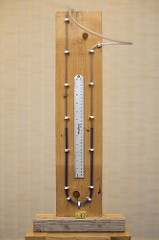I have a Carrier furnace and have recently replaced the inducer fan assembly in it. The old motor assembly had a piece of sheet metal dangling under it; whereas, the new one does not.
The unit worked fine for one day; however, now, after the main burner ignites, almost immediately all flames and the pilot light goes out.
I feel that the inducer motor cooling fan (looks like a black knob on top of the motor) might be blowing too much air downward and blowing out the flames and pilot light.
Could this really be true? Maybe that piece of sheet metal on the old one helped to block that downward air, and I need to install that old piece on the new assembly?
Thanks
UPDATE #1:
I tried to see if there were any LED error code lights on the board, but there are not (the board was replaced by a technician a couple years ago).
I added the sheet metal thingy to the new inducer motor and here is pic of what that looks like:
Here is model info:
Product: 58GFA070---11HC
Model: 58GFA070-HC
Series: 110
Serial: 4392A05699
After reinstalling it, the burners and pilot light immediately blew out again, but then later it seemed to work. It has been running fine for 1 or 2 days now. So, I'm not sure what is going on. What would be my next steps, if it blows out again.
PS - After the burners blow out the unit just blows cold air forever.


